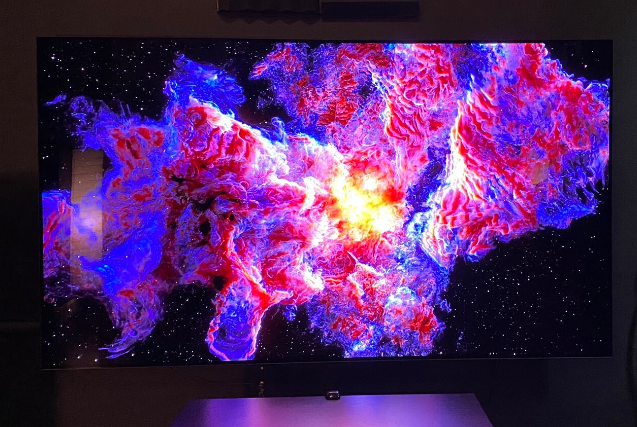Should I Buy an OLED?
So, here is your dilemma. You know that you want the very best picture that a flat screen can offer. Easy, get an OLED. Not so fast, I heard that OLED is prone to screen burn-in. Ok, I’ll get an LED. But wait, I want the best black levels and HDR performance. I’ll get an OLED. But wait, I play video games, and I might get burn-in. Ok, I’ll get an LED. But…ok stop.
Before you go cross-eyed and get into analysis paralysis, let’s put some facts to paper and hopefully, we can help you make an informed decision. And let me give this some credibility. I was in this same position last year, and I almost went with an LED over my OLED because of these same fears. But after doing some research and talking with OLED owners, I pulled the trigger on an LG B9, and I have never been happier.

What Is OLED?
So with most things, a brief science lesson is needed. OLED stands for Organic Light Emitting Diode. With OLED, each individual pixel emits light, whereas an LED uses a backlight to illuminate groups of pixels. This means that OLED panels do not dim sections of pixels, they turn them off, and this is why OLEDs have such fantastic contrast levels. This perfect contrast level makes them ideal for HDR content because they can create amazing contrast between very dark sections and brightly lit sections, making them pop! The OLED’s ability to turn off individual pixels contributes to their almost instantaneous response times, making them ideal for gaming.
What is Screen Burn-In?
Screen burn-in occurs when there is non-uniform use of pixels. In layman terms, it’s when you leave the same static image in the same spot for long periods without varying it. Like leaving your panel on a news network with their logo displayed at a specific location, and you watch it for hours on end without any change to that logo’s location. Or you are playing a video game with a static HUD on the screen for hours. That non-uniform use of pixels causes those particular pixels to either dim or diminish and, in some cases, burn-in a persistent ghost image into the screen that can be visible even when you switch content.

This burn-in or ghost image is problematic because you may see the ghost image all the time, or you will see a dimming or degradation of that section of pixels. This burn-in is exceptionally distressing when you weigh the cost of an OLED vs a traditional LED. No one wants to spend a premium on their panel, only to have it damaged permanently. I had the same fear but read on. There is some solace.
How to Avoid Screen Burn-In?
So there are some straightforward things you can do to prevent burn-in, and then there is some built-in protection in modern panels that can help avoid burn-in.
- Reduce your OLED light in your menu. Now don’t freak out. This reduction does not mean that your OLED will become so dim that you can’t watch it. In a reasonably dark room, you can get away with your OLED Light set to 50%. I have mine set at 50% in SDR content, and honestly, I can’t tell a massive difference between it at 100 and 50. HDR modes will automatically set it to 100%. So your HDR content will continue to look amazing.
- Vary your content! Doing this is one of the easiest things you can do. Are you playing a video game? Every few hours, take a break and maybe play something else. Or go outside and do something! Were you watching a news network? Change the channel and get your mind of the world for a while! Just be mindful of the content you watch.
- Use the built-in ABL and logo shifting features. The ABL, or Auto Brightness Limiting feature, will automatically start to limit your OLED’s light output on very bright (think a super bright snow scene) images and reduce it to prevent burn-in or excessive heat from building up. Logo shifting does what the name implies; it will pixel shift and dim (ABL) static logo images. You can choose how aggressive the ABL and logo shifting is if you find it distracting. I can personally say that I have mine set to the most aggressive settings, and I have never even noticed it.
- Allow the pixel refresh to run. All modern OLED panels have a pixel refresh that runs automatically when you watch something for four hours or more. To allow it to run, you need to keep the panel plugged in. It will keep the screen on when it is running, and you may see the occasional flash, but it will turn off the screen after it’s done.
- Use a screen saver. I have screen savers on all my devices, and I set them to turn on within a few minutes of an idle screen. The screen saver ensures that I will not have to worry about any image retention or screen burn-in if I walk away and forget. Put the other thing you can do is to turn off your screen.
- Buy burn-in warranty. Ok, so this is an added cost for sure. But, if you need peace of mind, you can purchase additional protection for your OLED. Be warned, not every retailer carries this, and there might be conditions attached. So read the fine print and educate yourself before you drop a few hundred extra on extended warranties.
I Have Screen Burn-In, What Can I Do?
Ok, so if you do get screen burn-in, you are not entirely out of luck. There are some things you can do before you throw in the towel and declare your OLED dead.
- Run the manual pixel refresh. This manual refresh is a much longer, deeper refresh of your pixels and should only be done when you see signs of pixel degradation. In some cases, this can fix the issues or reduce them to tolerable levels.
- Call the manufacturer. So this may be a dead-end, but it’s worth a try before you nerf a panel. I have read many reports of customers getting ahold of companies like LG and getting a one-time replacement on an OLED screen. Smart move by LG! This kind of feedback is what led me to move to an LG TV. But be warned, this may not be the case for everyone, and you may not get a replacement. But as I said, it’s worth a telephone call.
Should I Be Worried?
This is the question we want answered, isn’t it? So I will be upfront, I don’t have any long-term data to help you. My OLED is only one year old at this point, so if there were a defect, I would be shocked. But, to date, I have had no issues. I have read posts from owners that OLEDs, especially newer ones, have not reported burn-in from reasonable use. Older models (think 2016) report more burn-in because the OLED technology was newer, and there were not as many preventative measures built-in.
But don’t listen to just me. Rtings has undertaken a very significant burn-in test over a few generations of tvs. So far, the worst burn-in has been with the most egregious abuse of OLED panels with static images. Take the time to read their take and decide if the risk of burn-in applies to you.
Why You Should Buy An OLED
There are some pretty significant reasons you should buy an OLED TV. First off is HDR and Dolby Vision performance. Because OLED has an infinite contrast ratio, and it physically turns off individual pixels, HDR content is outstanding. Colors just pop on screen. One of the first things I watched in HDR was the opening scene to Blade Runner. The way the lights in the city scape stood out again that dark background completely wowed me. But aside from amazing HDR performance, SDR content looks fabulous. I always host a football party and my friends were wowed last year when they saw the quality of the image. And that was just plain ole 1080p off my cable box.
Another compelling reason is gaming. If you really want to have a next-gen experience, there is nothing quite like gaming, in HDR, at 4k 120. Latency is low, and response time is darn near instantaneous. While I do not consider myself anything other than a moderate skilled gamer, I can honestly say that I have improved in a number of shooter games with my OLED. Plus, gaming in HDR is just gorgeous.
Our Take
Screen burn-in is a real factor in choosing a new OLED panel. Yes, arguably, OLED offers the best experience that you can get on a flat panel. And yes, there are some risks associated with OLED panels. But, given all the things you can do to prevent screen burn-in. Plus all of the tools available now, OLED is not as much a risk as it once was. I think my position is pretty straightforward, and I would recommend purchasing an OLED. But as I did, I recommend you make your own decision, do your research, and come up with the best option for your setup.


